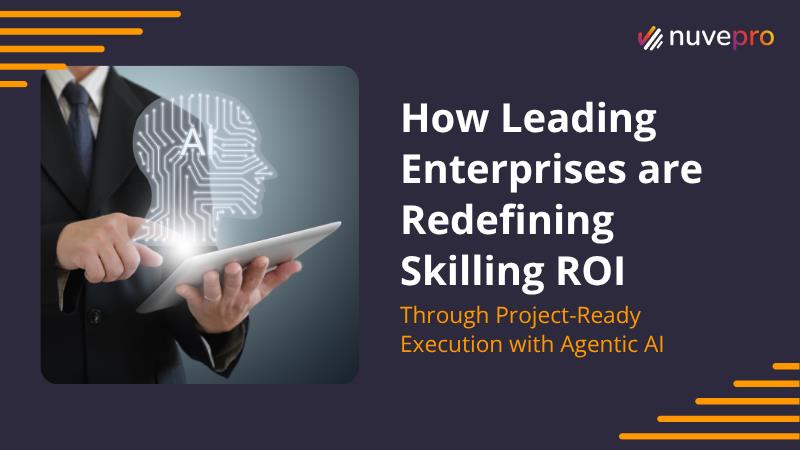LinkedIn Learning has been a powerful platform for professionals to enhance their skills and knowledge. It provides access to thousands of courses taught by industry experts on a variety of topics. However, one of the biggest challenges in online learning is the lack of hands-on learning experience, which can make it difficult for learners to apply what they’ve learned in real-world scenarios. But now, with Nuvepro’s hands-on labs integrated into every course, LinkedIn Learning just got better.
What are Hands-On Labs?
Hands-On Labs are a virtual environment where users can practise and experiment with what they have learned in a course. It’s a safe and controlled environment that allows learners to experience real-world scenarios without the fear of making mistakes that could cost them their jobs or cause damage. This practical approach provides an opportunity to apply newly acquired knowledge and build confidence in their abilities.
Why are hands-on labs so crucial?
As a learner, it’s crucial to have a hands-on learning experience to cement the knowledge gained during a course. Hands-on labs provide learners with the opportunity to learn by doing, which is a proven effective method of knowledge retention. This approach also allows learners to identify gaps in their understanding and learn from their mistakes, which ultimately leads to a deeper understanding of the subject matter.
The benefits of hands-on labs are not limited to learners alone. Employers also benefit from employees who have a practical understanding of the knowledge they have acquired. It helps to increase productivity and performance in the workplace as they can confidently apply their skills in a real-world environment.
How do Nuvepro Hands-On Labs help LinkedIn Learning get better?
Nuvepro is a cloud-based platform that specializes in providing virtual environments for IT professionals to practice and experiment with their skills. The platform, along with LinkedIn Learning, provides a hands-on learning experience for every course on the platform. Here are some of the ways in which Nuvepro Hands-On Labs helps enhance the LinkedIn Learning experience:
-
Seamless integration: Nuvepro Hands-On Labs integrate seamlessly with LinkedIn Learning’s existing platform, making it easy for learners to access the labs from the course page. Users don’t have to worry about navigating through a different platform to access the labs, which ensures a smooth learning experience.
-
Wide range of labs: Nuvepro offers a wide range of labs covering various IT domains, including cloud computing, cybersecurity, and data analytics. This diversity ensures that learners can find a lab that aligns with their interests and career goals, making it a personalised learning experience.
-
Flexibility: Nuvepro Hands-On Labs offer flexibility in terms of time and location. Learners can access the labs at any time and from anywhere, as long as they have an internet connection. This feature is particularly beneficial for professionals who have busy schedules or work remotely.
-
Real-world scenarios: Nuvepro Hands-On Labs simulate real-world scenarios, allowing learners to apply their knowledge practically. This feature helps learners develop critical thinking and problem-solving skills, which are essential in any IT job.
-
Personalized feedback: Nuvepro Hands-On Labs provide learners with personalized feedback, enabling them to identify areas where they need to improve. This feature helps learners focus on their weaknesses and learn from their mistakes, which ultimately leads to a deeper understanding of the subject matter.
What courses are covered by LinkedIn Learning Courses for Cloud?
LinkedIn Learning offers a wide range of courses on cloud computing, taught by industry experts. These courses cover various aspects of cloud computing, from the fundamentals to more advanced topics. Some of the popular courses include:
Amazon Web Services (AWS) Essential Training: In this course, learners will get an overview of AWS, including its services, architecture, and pricing. They will also learn how to set up an AWS account and create virtual machines, storage, and databases.
Microsoft Azure Essential Training: This course provides an introduction to Microsoft Azure, including its services, architecture, and pricing. Learners will learn how to create and manage virtual machines, storage, and databases in Azure.
Google Cloud Platform Essential Training: In this course, learners will learn about Google Cloud Platform, including its services, architecture, and pricing. They will also learn how to create and manage virtual machines, storage, and databases on the Google Cloud Platform.
DevOps Foundations: In this course, learners will learn about the DevOps culture and how it can be applied to cloud computing. They will also learn about the tools and techniques used in DevOps, including continuous integration and continuous deployment.
Containers Essential Training: In this course, learners will learn about containerization and how it can be used in cloud computing. They will also learn how to create and manage containers using Docker.
Conclusion
LinkedIn Learning just got better with Nuvepro’s hands-on labs. These cloud labs provide practical experience, allowing learners to apply what they’ve learned in real-world scenarios. Nuvepro, along with LinkedIn Learning, offers learners a personalised and immersive learning experience. By providing users with a practical experience, Hands-On Labs can help to enhance LinkedIn Learning in a better way. Additionally, LinkedIn Learning offers a range of courses covering various IT domains, including cloud computing.
Hands-On Labs can provide practical experience to complement these courses, allowing learners to experiment and apply their knowledge in a safe and controlled environment. Overall, Hands-On Labs are an excellent addition to the LinkedIn Learning platform and a valuable tool for IT professionals looking to stay updated on the latest technologies. With these cloud labs for learners, they can experiment, explore, and build practical experience, which can be invaluable when seeking upcoming job opportunities or advancing in their careers.
If you’re interested in cloud computing, LinkedIn Learning offers a wide range of courses on this topic, taught by industry experts. With Nuvepro’s hands-on labs, you can develop practical experience in cloud computing, which can help you stand out in a competitive job market. So, why not give it a try and take your skills to the next level?




